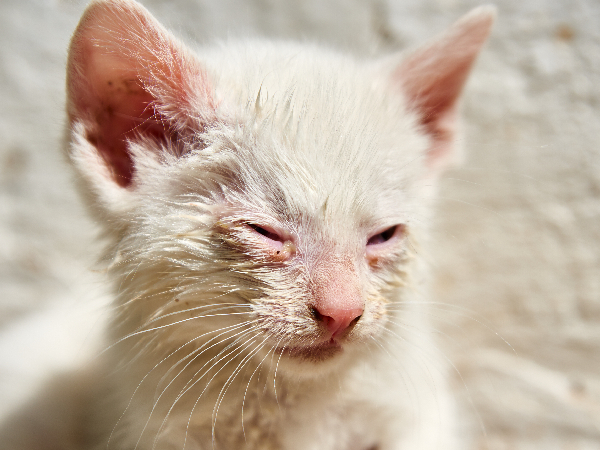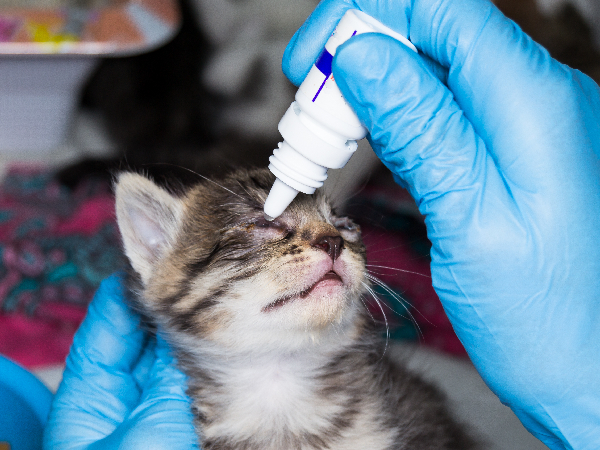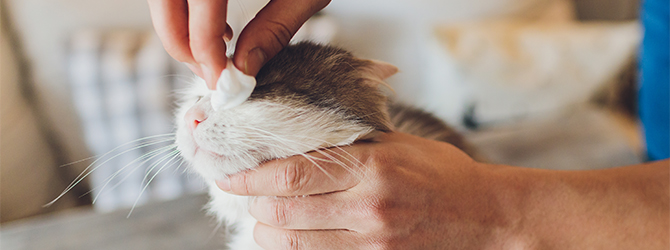Conjunctivitis in cats: Is your cat's eye discharge serious?
First Published: 19/06/2018
Last Updated: 24/11/2023
Conjunctivitis is inflammation of the eye, usually caused by a viral infection like feline herpes or a bacterial infection like chlamydia. However, conjunctivitis can also be caused by an injury to the eye or eyeball, such as a scratch or a chemical irritant. It is also commonly known as 'Pink-eye' because one of the main symptoms of conjunctivitis in cats is pink or red eyes.
A brief summary…
- Conjunctivitis is a common, painful, and contagious condition
- Symptoms include red or pink eyes, sticky eyes, squinting, excessive blinking, and discharge
- Main causes are viruses, bacterial infections, and external irritants like dust, scratches, or allergens
- Prompt treatment from a vet is essential, usually involving eye drops or ointments
- Prevention measures include vaccinating against cat flu, reducing irritants in the home, and regularly grooming and monitoring cats
What is conjunctivitis in cats
Conjunctivitis in cats is a common problem that affects the conjunctiva, which is the thin membrane that covers the inside of the eyelids and the whites of their eyes. When the conjunctiva is healthy, it is practically invisible. It protects your cat's eyes from dirt, bacteria, parasites and anything else that could harm them.
It occurs when this protective membrane becomes inflamed. This causes the eye to become red and swollen. The eye might also water or have some discharge, which can look like 'gunk'. It's a painful, irritating experience for your cat and can be treated easily with eye drops if administered early. Unfortunately, it's also highly contagious between cats and, if left untreated, can lead to blindness.
Cat conjunctivitis symptoms
.png)
Cat conjunctivitis symptoms can vary, but if your cat is showing some or all of the following symptoms, then they may have conjunctivitis. These can include:
- Red or pink eyes
- Sticky eyes
- Squinting (caused by not wanting to be near bright lights)
- Excessive blinking
- A watery, wet eye
- Yellow, greenish or cloudy discharge
Cats may also show signs of cat flu, mainly:
- Sneezing
- Runny nose
- Fever
- Lethargy
- Lack of appetite
Your cat might show other signs of irritation, like rubbing or pawing at their eyes. This can be with their paws or on furniture or the carpet. Your cat will do this to try to get some relief from the irritation and possibly remove what they think is causing the pain.
If your cat is showing any symptoms, then speak to your vet. Conjunctivitis is relatively easy to treat. Acting quickly will help your cat with the most irritating and painful symptoms.

Causes of conjunctivitis in cats
Although there are quite a few causes of feline conjunctivitis, they can be broken down into three main groups: viruses, bacterial infections, and outside irritants.
Viruses
When viruses cause conjunctivitis, it is called infectious conjunctivitis. The most common virus that causes conjunctivitis is feline herpesvirus. Feline herpesvirus is a contagious disease that causes breathing and eye problems in cats. Other infectious viruses that can cause conjunctivitis are cat flu and calicivirus.
Bacterial infections
Conjunctivitis in cats can also be caused by bacteria in the eye. Bacteria that can cause conjunctivitis, such as chlamydophila, are highly contagious.. Younger cats and cats that live in multi-pet households or spend time in catteries will be at a greater risk of bacterial conjunctivitis. If your cat suffers from bacterial conjunctivitis, they will generally be treated with antibiotics.
Outside irritants
There are a whole host of external irritants that can affect your cat's eyes and lead to conjunctivitis, including:
- Dust
- Scratches on the cornea
- Sand
- Litter from their tray
- Eyelashes growing in the wrong place or direction
- Eyelid issues such as baggy eyelids or eyelids that are turned in
- Skin allergies
When should I see my vet?
Conjunctivitis will not go away by itself, and you will need to visit your vet to receive treatment. To clear up the issue as quickly as possible and remove the irritation and pain from your cat, speak to your vet as soon as you see any symptoms. Treated early, cat conjunctivitis will clear up in around seven to 14 days. It is also essential to see the vet if your cat has a sore or weepy eye, as if they have a scratch (corneal ulcer) this if very painful, and can result in loss of the eye if left untreated.
Diagnosing feline conjunctivitis
While conjunctivitis isn't life-threatening, it can be contagious – and unpleasant for your cat. If left untreated, the infection may spread and cause damage to other parts of the eye and, ultimately, your cat's eyesight.
Your vet will make their diagnosis based on your cat's symptoms. Because the symptoms of conjunctivitis in cats are mainly physical, your vet should be able to diagnose the issue with a general examination.
However, they may also check for underlying causes, such as feline herpesvirus or cat flu, to treat the cause, not just the symptoms.

Cat conjunctivitis treatment
Your vet will carefully examine the eye and may take a culture sample of the fluid around your cat's eye to establish whether the cause of the conjunctivitis is viral or bacterial so that they can recommend the most effective treatment. Your vet may also put a drop of orange dye into the eye to check for scratches and corneal ulceration.
Treatment often involves anti-inflammatory or antibiotic eye drops or ointment, and your cat should show signs of improvement within just a couple of days of starting treatment.
As with any medication, it's essential to finish the course prescribed by your vet – even when you notice your cat starting to improve – to reduce the chances of recurring infection.
Preventing conjunctivitis in cats
Although there is no vaccine for conjunctivitis in cats, there are ways you can help prevent it. One of these is vaccinating against some infectious causes, especially cat flu. As cat flu is a serious disease that often leads to conjunctivitis, vaccinating your cat against it will help prevent both issues. Cat flu is part of the recommended core vaccinations in the UK, check with your vet if you aren’t sure if your cat is up to date with their vaccines. Pet Health Club™ members receive all core vaccinations, plus yearly boosters, as part of their plan.
Decreasing the irritants you have in your home will also help prevent feline conjunctivitis. This could involve not smoking around your pets or using pet-friendly sprays and cleaning products. Grooming your cat regularly not only allows you to spend time bonding with your pet but also enables you to check around their eyes to ensure they aren't at risk of getting foreign objects in them, especially eyelashes.
Due to the contagious nature of conjunctivitis, it’s crucial to monitor outdoor cats and those in multi-cat households for signs of conjunctivitis to ensure prompt and effective treatment.
Studies into conjunctivitis in cats
There have been several academic studies into conjunctivits in cats, including research published in the Journal of Feline Medicine and Surgery in 2018 which found that bacterial infections, viral infections, allergies, and trauma are the most common causes.
Another piece of research from Veterinary Ophthalmology in 2019 concluded that the most common symptoms are eye discharge, redness of the eye, squinting, and pawing at the eye. Meanwhile, a review published in the Journal of Feline Medicine and Surgery in 2020 found that treatment of conjunctivitis in cats varies depending on the underlying cause, with antibiotics, antiviral medications, and anti-inflammatory drugs most commonly used to treat it.
Another study published in Veterinary Ophthalmology in 2017 found that some cats develop chronic conjunctivitis, which can be difficult to treat. The researchers found a link between feline herpesvirus infection and chronic conjunctivitis. Finally, a study published in the Journal of Feline Medicine and Surgery in 2015 found that regular vaccination of cats against common viral infections, such as feline herpesvirus, can help prevent conjunctivitis.
Common questions around conjunctivitis
How serious is cat conjunctivitis?
Topical and antibiotic eye drops should clear up bacterial conjunctivitis within a couple of weeks. If treated, then conjunctivitis will cause no long-term harm.
How long does conjunctivitis in cats last?
With treatment, most cases of feline conjunctivitis will clear up in seven to 14 days. However, severe or complex cases caused by cat flu or irritants may take much longer to control.
What can happen if conjunctivitis goes untreated?
If left untreated, conjunctivitis can have severe consequences for your cat. Not only does it negatively impact your cat's general well-being, but if left untreated, it can also lead to necrosis of the cornea, which is when the cornea begins to die. It develops slowly but is incredibly painful for cats and generally leads to blindness.
Need advice on preventing conjunctivitis?
For expert advice on the prevention and treatment of conjunctivitis in your cat, contact your local vet.
Find your nearest vet using our Find a Vet page, or speak to a vet online using Online Vets.



